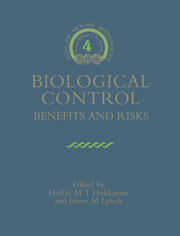Book contents
- Frontmatter
- Contents
- List of Contributors
- Series Preface
- Preface: Overview of Benefits and Risks of Biological Control Introductions
- Part I Biological Invasions
- Part II Classical Biocontrol
- Part III Augmentative Biocontrol
- 9 The Use of Exotic Organisms as Biopesticides: Some Issues
- 10 Use of Trichogramma in Maize – Estimating Environmental Risks
- 11 Entomopathogenic Nematodes in Biological Control: Feasibility, Perspectives and Possible Risks
- 12 Pseudomonads as Biocontrol Agents of Diseases Caused by Soil-borne Pathogens
- 13 Biological Control of Soil-borne Pathogens of Wheat: Benefits, Risks and Current Challenges
- 14 Genetically Engineered Fluorescent Pseudomonads for Improved Biocontrol of Plant Pathogens
- 15 Biological Control of Foliar Fungal Diseases
- 16 The Use of Fungi, Particularly Trichoderma spp. and Gliocladium spp., to Control Root Rot and Damping-off Diseases
- 17 Bacillus thuringiensis in Pest Control
- 18 Opportunities with Baculoviruses
- Part IV Use of Genetically Modified Organisms
- Part V Economics and Registration
- Index
14 - Genetically Engineered Fluorescent Pseudomonads for Improved Biocontrol of Plant Pathogens
Published online by Cambridge University Press: 07 May 2010
- Frontmatter
- Contents
- List of Contributors
- Series Preface
- Preface: Overview of Benefits and Risks of Biological Control Introductions
- Part I Biological Invasions
- Part II Classical Biocontrol
- Part III Augmentative Biocontrol
- 9 The Use of Exotic Organisms as Biopesticides: Some Issues
- 10 Use of Trichogramma in Maize – Estimating Environmental Risks
- 11 Entomopathogenic Nematodes in Biological Control: Feasibility, Perspectives and Possible Risks
- 12 Pseudomonads as Biocontrol Agents of Diseases Caused by Soil-borne Pathogens
- 13 Biological Control of Soil-borne Pathogens of Wheat: Benefits, Risks and Current Challenges
- 14 Genetically Engineered Fluorescent Pseudomonads for Improved Biocontrol of Plant Pathogens
- 15 Biological Control of Foliar Fungal Diseases
- 16 The Use of Fungi, Particularly Trichoderma spp. and Gliocladium spp., to Control Root Rot and Damping-off Diseases
- 17 Bacillus thuringiensis in Pest Control
- 18 Opportunities with Baculoviruses
- Part IV Use of Genetically Modified Organisms
- Part V Economics and Registration
- Index
Summary
Introduction
A major attraction of the application of genetic engineering to microbial inoculant strains is the ability to create new strains with capabilities that may not be easily obtained by a process of natural selection. Such additional features may enhance the performance of an inoculant strain.
The fluorescent Pseudomonas species are an important group of bacteria that can play a beneficial role in the protection of crop plants against deleterious pathogenic micro-organisms. These bacteria produce a wide range of factors antagonistic to pathogens (particularly fungi) they include the yellow-green, fluorescent siderophores that characterize this group.
Our work has concentrated on the role of siderophores and antibiotics of fluorescent Pseudomonas in the biocontrol of ‘damping-off’ disease of sugar-beet seedlings (see Table 14.1). The biosynthesis and excretion of iron-binding siderophores are thought to decrease the pool of iron available to pathogenic fungi and other harmful micro-organisms and so contribute to the plant growth promotion effect observed when plants are inoculated with the appropriate Pseudomonas strain (Kloepper et al 1980). The producing micro-organism can use the resulting Fe3+ (ferric) siderophore complex via specific receptors located in its outer membrane (Magazin et at., 1986).
Outer membrane receptor proteins can be highly specific and only transport the appropriate ferric siderophore into the producing cell. The structures of these fluorescent (yellow-green) siderophores was reviewed by Leong (1986). Fluorescent siderophores are only produced under iron-limiting conditions, as are receptor proteins.
Information
- Type
- Chapter
- Information
- Biological ControlBenefits and Risks, pp. 161 - 166Publisher: Cambridge University PressPrint publication year: 1995
Accessibility standard: Unknown
Why this information is here
This section outlines the accessibility features of this content - including support for screen readers, full keyboard navigation and high-contrast display options. This may not be relevant for you.Accessibility Information
- 1
- Cited by
